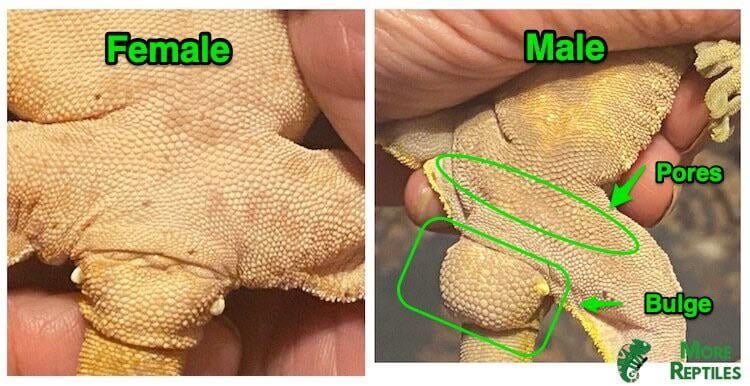Wondering how to tell if a crested gecko is male or female? The key lies in understanding subtle physical differences. Males typically have larger pores and a prominent bulge at the base of their tail. Females, on the other hand, may have a more rounded body shape. By observing these indicators, you can confidently determine the gender of your crested gecko. Let’s delve into this fascinating process and unravel the mystery of identifying male and female crested geckos.
Discovering the Gender of Your Crested Gecko: Male or Female?
Introduction: Understanding Crested Geckos
Crested geckos are fascinating creatures that make wonderful pets. They are known for their unique appearance, including the crest of skin that runs from their eyes down to their tail. One common question that new crestie owners often have is how to determine the gender of their gecko. In this guide, we will delve into the world of crested geckos and learn how to tell if your gecko is male or female.
Physical Characteristics: Male vs. Female Crested Geckos
When it comes to determining the gender of your crested gecko, there are several key physical characteristics to look for.
Hemipenal Bulges
One of the most reliable ways to differentiate between male and female crested geckos is by examining the hemipenal bulges. These bulges are located near the base of the tail and are more pronounced in male geckos. If you gently lift your gecko’s tail and observe two distinct bulges, it is likely a male.
Femoral Pores
Another indicator of gender in crested geckos is the presence of femoral pores. These tiny pores are located on the undersides of the hind legs and are more prominent in male geckos. If you notice these pores when examining your gecko, it is likely a male.
Tail Base Thickness
In some cases, male crested geckos may have a thicker base to their tail compared to females. This can be a subtle difference, but with close observation, you may be able to discern this distinction.
Behavioral Cues: Male vs. Female Characteristics
In addition to physical traits, the behavior of your crested gecko can also provide clues about its gender.
Calling Behavior
Male crested geckos are known for their distinctive calling behavior, which they use to attract females during the breeding season. If you hear your gecko making chirping or clicking sounds, it is likely a male trying to court a female.
Aggression and Territoriality
Males may exhibit more aggressive or territorial behavior, especially towards other males. If you notice your gecko displaying these behaviors, it could be an indication that it is a male.
Egg-Laying Behavior
Female crested geckos may display nesting behavior or dig in their substrate as if preparing to lay eggs. If you observe these actions in your gecko, it is likely a female.
Professional Assistance: Consulting a Veterinarian
If you are still uncertain about the gender of your crested gecko after observing physical and behavioral traits, it is advisable to seek the expertise of a reptile veterinarian. A vet can perform a closer examination and provide a definitive answer regarding your gecko’s gender.
Conclusion: Enjoying Your Crested Gecko Companion
Determining the gender of your crested gecko can be an exciting part of the journey of pet ownership. By observing physical characteristics and behaviors, you can gain a better understanding of your gecko and provide the best care possible. Remember, whether you have a male or female crested gecko, what matters most is the bond you share with your unique and wonderful pet.
In conclusion, understanding the gender differences in crested geckos can enhance your experience as a pet owner and deepen your connection with these amazing creatures. Take the time to observe and appreciate the individual traits of your gecko, and enjoy the journey of caring for your new reptilian friend.
How to tell if your CRESTED GECKO is Male or Female? Tips on how to Sex a Crested Gecko
Frequently Asked Questions
How can I determine the gender of a crested gecko?
To determine the gender of a crested gecko, you can look at the base of their tail. Males typically have a more pronounced bulge at the base of their tail, which is where their hemipenes are located. Females, on the other hand, usually have a slimmer tail with no noticeable bulge.
At what age can I reliably determine if a crested gecko is male or female?
It is generally easier to determine the gender of a crested gecko once they reach sexual maturity, which is usually around 8-12 months of age. At this stage, the differences in tail shape and size between males and females become more apparent.
Are there any other physical characteristics I should look for to identify the gender of a crested gecko?
In addition to the size and shape of the tail, you can also observe the pores located underneath the hind legs. Males tend to have pre-anal pores, which are small bumps or pores that release a waxy substance. Females usually lack these pores.
Final Thoughts
To determine if a crested gecko is male or female, focus on the presence or absence of hemipenal bulges. Males have these bulges at the base of their tail, while females lack them. Additionally, examine the overall size and shape differences between the sexes. Remember, understanding these physical characteristics is essential in identifying how to tell if a crested gecko is male or female correctly.




